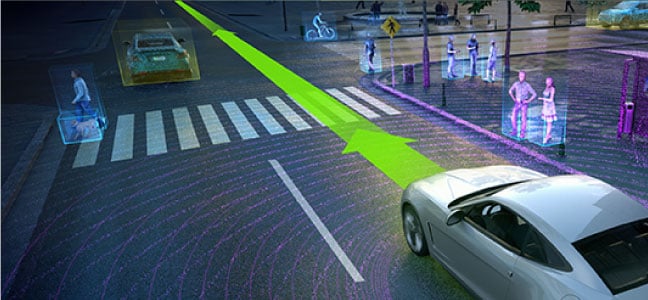
Image source: NVIDIA.
NVIDIA's (NVDA +0.47%) not exactly the first company to come to mind when investors think about investing in the automotive industry, but it should be. The chipmaker is driving further into the the infotainment space with its Tegra chips, and its second-generation Drive PX platform is already gaining traction with automakers.
The company is in excellent position to gain from the self-driving autos trend and NVIDIA recently shed some light on its automotive business in its fiscal year 2016 annual report that makes the stock worth a serious look.
$320 million
The chipmaker's full-year automotive segment revenue totaled $320 million in fiscal 2016, which is an amazing 75% increase year over year. Previous full-year automotive revenue in fiscal 2015 was just $183 million.
While that's an impressive increase, it's worth noting that the automotive segment isn't anywhere near the NVIDIA's largest revenue driver. That title is held by the company's gaming chip segment, which brought in $2.8 billion in revenue in fiscal 2016.
But NVIDIA's automotive growth shouldn't be overlooked. The company is just at the beginning stages of bringing in automotive revenue after a slew of design wins. NVIDIA's CEO, Jen-Hsun Huang, said a few years ago that he envisions the automotive segment easily reaching $1 billion in revenue in the near future. While NVIDIA clearly hasn't hit that yet, the auto segment's growth indicates that it's well on its way.
10 million
At the end of fiscal 2016, NVIDA's Tegra chips were in more than 10 million vehicles, up from about 7.5 million in fiscal 2015 (a gain of about 33% year over year). The company boasts an impressive list of customers including Mercedes-Benz, Audi, Porsche, Bentley, and Honda. And Tesla Motors (TSLA +2.54%) relies on NVIDIA's chips to power the infotainment system for its all-electric Model S sedan and its new Model X SUV. That's great news for NVIDIA, considering that the Model S was the best-selling luxury car in the U.S last year.
And NVIDIA's not done adding additional autos, either. At the end of Q4 2016, Huang said that, "We've shipped probably 5 million, 6 million cars. We have another 20 million, 25 million cars to ship in our pipeline. And so these are design wins that took quite a few years to have won and quite a few years of engineering to ramp into production. So we have a pretty good visibility of the pipeline and the opportunities that are ahead of us."
70
That's the number of automakers, tier 1 suppliers, and research groups that are currently using the company's semi-autonomous and autonomous car platform, Drive PX -- and you can expect this number to grow.
NVIDIA's newly updated autonomous car platform, Drive PX 2, already has its first customer in Volvo. The carmaker will implement NVIDIA's technology into 100 autonomous SUVs by 2017, as part of the automaker's DriveMe autonomous car initiative.
This, of course, is just the tip of the autonomous car market for NVIDIA. IHS Automotive estimates there will be 12 million self-driving cars sold annually by 2035. With that number approaching over the next two decades, NVIDIA's Drive PX platform (and its revenue) is poised to benefit.








